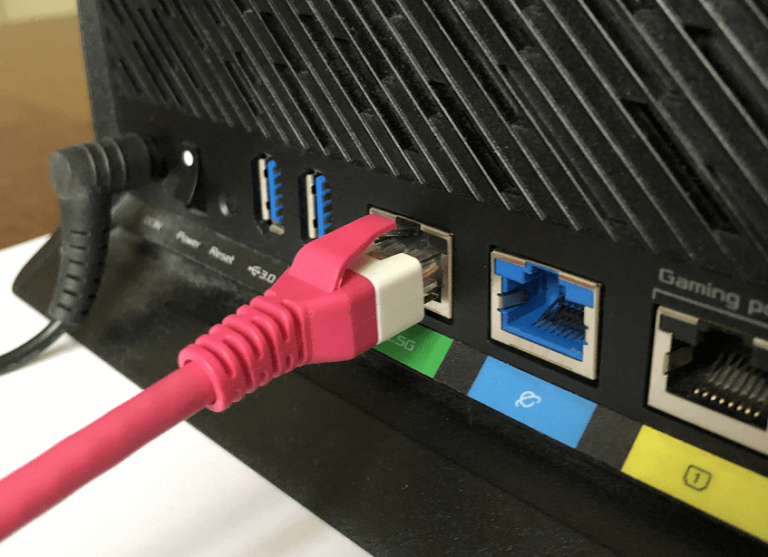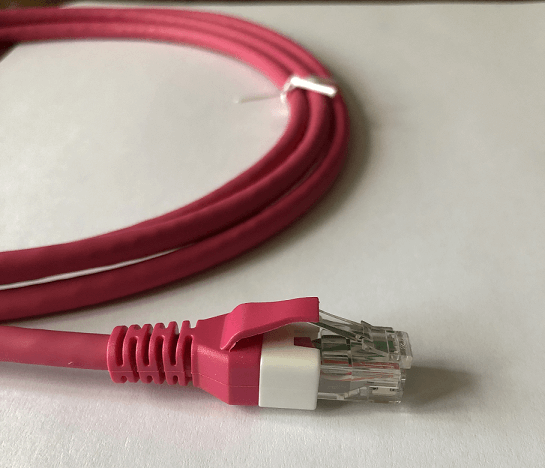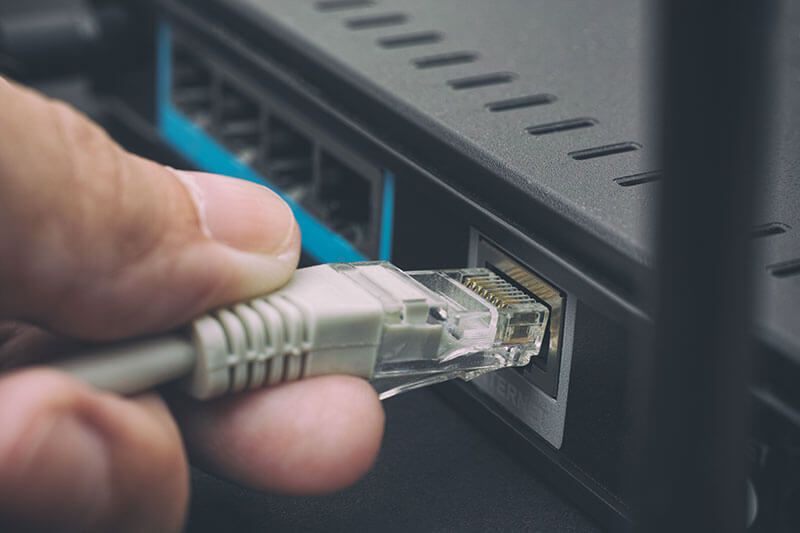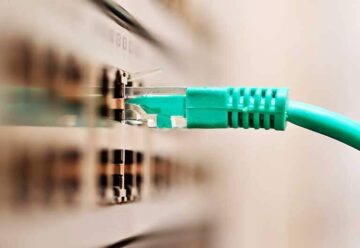Get high-bandwidth business Ethernet
What is Ethernet?
Ethernet is a networking technology that connects devices by cable to local area networks (LANs) for high-bandwidth data transmission. For example, if you plug your desktop computer or laptop into a router at home or work, you use Ethernet to connect to the network.
Since it’s a wired connection, Ethernet typically provides higher speeds, lower latency, and greater security than Wi-Fi (WLAN).
Ethernet cable plugged into a home router

When first introduced in the 1980s, Ethernet delivered speeds of 10Mbps for local networks. Since then, it’s evolved into Carrier Ethernet, which offers speeds of up to 100Gbps or more over long distances.
Today, Ethernet is used in a wide range of applications, from small home LANs to large enterprise wide area networks (WANs) and metropolitan area networks (MANs). It forms the backbone of many wired communication networks worldwide.
How does Ethernet work?
Ethernet divides data into small chunks called frames, which are transmitted over standardised cables. Ethernet works primarily at the Data Link Layer (layer 2) of the OSI model, with some elements operating at the Physical Layer (layer 1).
The seven layers of the OSI Model
| # | Layer | Function |
| 7 | Application Layer | Enables humans or software to interact with the network through applications like file sharing, email clients and databases |
| 6 | Presentation Layer | Formats, encrypts and decrypts data for the application layer |
| 5 | Session Layer | Starts, maintains and ends connections between applications |
| 4 | Transport Layer | Transfers data across the network, for example, using TCP or UDP transport protocols |
| 3 | Network Layer | Enables communication between multiple networks and determines the data’s path, for example, applying IP addresses |
| 2 | Data Link Layer | Manages connections between physically connected nodes on a network |
| 1 | Physical Layer | Transmits raw data bits over physical media like cables or wireless connections |
At the physical layer, Ethernet typically uses twisted-pair copper or fibre optic cables to connect devices. For example, below is a twisted-pair Ethernet cable with a standard RJ45 connector.
Ethernet cable and RJ45 connector

At the data link layer, Ethernet defines the protocols used to transmit data between connected devices as follows.
MAC addresses
Ethernet uses 48-bit Medium Access Code (MAC) addresses. MAC addresses uniquely identify devices on the network.
Ethernet frames
To transmit data, Ethernet packages data into frames containing the source and destination MAC addresses, error-checking data and other standard information. Only devices on the network with the matching destination MAC address will process the frame.
Collision handling
In traditional Ethernet, if two devices transmit data simultaneously, a collision occurs. To prevent this, devices ‘listen’ to the network to see if it’s free. They use CSMA/CD (Carrier Sense Multiple Access with Collision Detection) – an algorithm that allows frames to be retransmitted without collisions.
Today, modern Ethernet networks use switches to forward frames to MAC addresses on the network, reducing collisions and enhancing performance.
In addition, ‘full-duplex mode’ allows devices to send and receive data simultaneously, doubling the network bandwidth. The total available bandwidth of an Ethernet network depends on the standard used.
Ethernet standards
First standardised in 1983 as IEEE 802.3, Ethernet initially used thick coaxial cables to transmit data at a maximum of 10Mbps over a few hundred metres (10BASE5). This was a shared medium, meaning all devices were connected through one channel on a single cable.
Since then, Ethernet has evolved to use twisted pair and fibre optic cables with switches to forward data to the destination device. Today, Ethernet standards include Fast Ethernet (100Mbps), Gigabit Ethernet (1Gbps) and 10 Gigabit Ethernet (10Gbps) – see table below for details.
Common Ethernet standards
(Note: Multimode fibre optic cables divide optical wavelengths into multiple paths for different channels; single-mode fibre cables feature a single path for longer distances.)
| Ethernet standard | IEEE specification | Max speed | Max distance | Common name |
| 10BASE5 | 802.3 | 10Mbps | 500m (coaxial) | Thicknet |
| 10BASE2 | 802.3a | 10Mbps | 185m (coaxial) | Thinnet |
| 10BASE-T | 802.3i | 10Mbps | 100m (twisted pair) | 10 Megabit Ethernet |
| 100BASE-TX | 802.3u | 100Mbps | 100m (twisted pair) | Fast Ethernet |
| 100BASE-FX | 802.3u | 100Mbps | 2km (fibre optic, multimode) | Fast Ethernet |
| 1000BASE-T | 802.3ab | 1Gbps | 100m (twisted pair) | Gigabit Ethernet |
| 1000BASE-SX | 802.3z | 1Gbps | 550m (fibre optic, multimode) | Gigabit Ethernet |
| 1000BASE-LX | 802.3z | 1Gbps | 5km (fibre optic, single-mode) | Gigabit Ethernet |
| 10GBASE-T | 802.3an | 10Gbps | 100m (twisted pair) | 10 Gigabit Ethernet |
| 10GBASE-SR | 802.3ae | 10Gbps | 300m (fibre optic, multimode) | 10 Gigabit Ethernet |
| 10GBASE-LR | 802.3ae | 10Gbps | 10km (fibre optic, single-mode) | 10 Gigabit Ethernet |
| 40GBASE-T | 802.3bq | 40Gbps | 30m (twisted pair) | 40 Gigabit Ethernet |
| 40GBASE-SR4 | 802.3ba | 40Gbps | 150m (fibre optic, multimode) | 40 Gigabit Ethernet |
| 40GBASE-LR4 | 802.3ba | 40Gbps | 10km (fibre optic, single-mode) | 40 Gigabit Ethernet |
| 100GBASE-SR10 | 802.3bj | 100Gbps | 100m (fibre optic, multimode) | 100 Gigabit Ethernet |
| 100GBASE-LR4 | 802.3bj | 100Gbps | 10km (fibre optic, single-mode) | 100 Gigabit Ethernet |
The latest standards can support speeds up to 400Gbps (IEEE 802.3bs), and 800Gbps and 1 Terabit Ethernet are currently under development.
Most Ethernet-enabled devices are backwards compatible with lower-speed Ethernet standards. However, the maximum connection speed will be limited to that of the slowest network component.
Get high-bandwidth business Ethernet
Ethernet components
Ethernet uses several standardised components that work together to enable data transfer. Here are some of the key elements of an Ethernet network:
- Network interface cards (NICs): Also known as network adapters, NICs are components in devices like servers, computers and printers that allow them to ‘talk’ to an Ethernet network.
- Ethernet cables: Cables physically connect devices to the network and come in various categories depending on the bandwidth required. For example, twisted-pair Category 5e (Cat5e) and Category 6 (Cat6) cables are commonly used for Gigabit Ethernet. Fibre optic cables are used for longer distances.
- Ethernet ports and jacks: Ports are the physical sockets on devices that Ethernet cables plug into using a standard RJ45 connector (see image above); jacks are the wall sockets that allow you to plug into an Ethernet network, for example, at work.
- Switches: Switches connect multiple devices to a network and manage data traffic. As they only forward data to the destination device, they reduce data collisions and improve network efficiency.
- Hubs: A legacy component in older networks, hubs connect multiple devices to a network. But unlike switches, they broadcast data to all devices on the network, so they’re less efficient.
- Routers: Routers connect different networks, such as LANs, to the internet. They assign IP addresses, route data traffic and ensure network security.
As components are standardised, Ethernet networks are often ‘plug-and-play’ with little or no setup required – one of several advantages of Ethernet connectivity.
Why use Ethernet connectivity?
Ethernet is widely used in various business applications due to several key advantages. Here are the main benefits of Ethernet.
Speed
Ethernet provides low latency, high-speed data transmission up to 100Gbps or more. That’s ideal for large file transfers or tasks requiring near real-time data exchange, like video conferencing, financial transactions, cloud applications or other mission-critical networks.
Cost
Ethernet components are widely available, relatively cheap, and easy to install. So Ethernet can deliver high capacity connectivity at a relatively low cost.
Scalability
Ethernet network speeds are easy to scale up as you grow. And you can usually add devices to the network by connecting Ethernet cables and switches with minimal setup.
Reliability
Ethernet networks are less susceptible to interference or disruption than wireless connections. In addition, good business Ethernet services typically offer Service Level Agreements (SLAs) guaranteeing network uptime.
Security
Compared to wireless local area networks (WLAN), Ethernet networks are less vulnerable to unauthorised access. Access to Ethernet ports is easier to control than wireless access points.
Interoperability
Since Ethernet is a widely adopted standard, almost all computers, printers and network storage devices support it. This standardisation ensures compatibility between devices from different vendors.
Given its versatility and high bandwidth, Ethernet today is not only used for local and wide area networks. It’s also ideal for data-hungry tasks like connecting data centres, IoT/IIoT applications, cloud services, and telecoms backhaul and backbone networks.
Types of business Ethernet services
Various Carrier Ethernet services provide high-bandwidth data transmission for enterprise applications. Below are the main types of Carrier Ethernet services, as defined by the Metro Ethernet Forum:
Carrier Ethernet services
| Service type | Topology | Description |
| E-Line (Ethernet Line Service) | Point-to-point or point-to-multipoint | Directly connects two business sites |
| E-LAN (Ethernet LAN Service) | Multipoint-to-multipoint | Allows multiple sites to exchange data directly with each other |
| E-Tree (Ethernet Tree Service) | Rooted multipoint | Connects a central site to multiple sites, but the “leaves” (branch nodes) of the tree don’t exchange data directly |
| E-Access (Ethernet Access Service) | Network-to-network | Provides a local access connection to another carrier’s network |
Good network service providers typically offer various business Ethernet services based on these standards.
Get high-bandwidth business Ethernet
Choosing a business Ethernet service
Which service is right for your business depends on your specific needs. At Neos Networks, we offer a range of business Ethernet services you can scale up to 100Gbps. Here are some services we can configure for your business.
Point-to-NNI
If you’re a larger customer and want to connect multiple premises back to your network, an Ethernet network-to-network interface (NNI) could be ideal. With point-to-NNI connectivity, you can connect your sites as efficiently as possible at bandwidths you can scale.
Ethernet point-to-NNI

Point-to-point Ethernet
If you need a high-bandwidth, low latency connection between two locations, Ethernet Private Line (EPL) is a good choice. A kind of E-Line service, EPL provides Ethernet point-to-point (P2P) connectivity between a pair of dedicated user network interfaces (UNIs).
EPL point-to-point Ethernet

Point-to-multipoint Ethernet
If you want to connect multiple sites, Ethernet Virtual Private Line (EVPL) may be for you. EVPL is a type of E-Line service that supports point-to-multipoint (P2MP) connectivity by enabling multiple Ethernet Virtual Connections (EVCs) per UNI.
EVPL point-to-multipoint Ethernet


Overall, which Ethernet service is right for your business depends on your specific use case, budget, and plans for future growth. If you’d like to discuss which is best for your business, get in touch. We’ll be happy to make Ethernet work for you.





